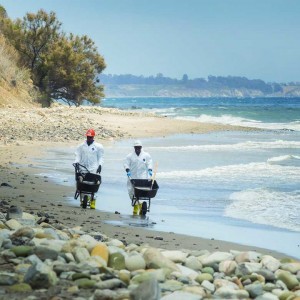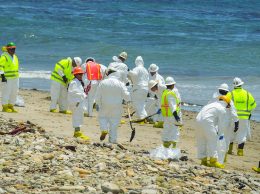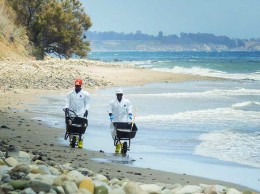Plains has spent more than $60 million on Refugio oil spill cleanup
IN THIS ARTICLE
- Central Coast Topic
- Elijah Brumback Author
By Elijah Brumback Friday, June 12th, 2015
Plains All American Pipeline, the company responsible for spilling thousands of gallons of crude oil on the Gaviota Coast, said Friday it has spent more than $60 million on clean up efforts to date.
There is no timeline on how long it will take to call the response complete, but the most recent update from Plains reports 85 percent of the beach miles affected by the spill have met cleaning goals.
A spokeswoman for Plains said the company is spending about $3 million per day in clean-up related activities. However, that number is expected to decline relatively quickly as more mitigation goals are met.
Questions regarding Plains’ response time and notification to pipeline oversight authorities has been highly scrutinized, leaving many wondering why the company took so long to notify anyone of the spill.
While the lag in reporting the incident is troublesome, the pipeline was shut down soon after irregularities in pressure were reported. Once oil is leeched onto land or into the ocean — as several thousand gallons were in this case — an immediate clean up response is almost entirely futile.
A March 2002 report from the County of Santa Barbara Planning and Development Energy Division states there is a common misconception that rapid oil spill response with modern spill clean-up technology, such as provided by the Clean Seas fleet, offers an effective antidote for oil spills.
Such is not the case. Once in the ocean, the oil is difficult to contain and recover. Even under the best conditions of calm weather and rapid response, mechanical recovery methods (i.e., booms, skimmers, and absorbent materials) are generally unable to recover more than 10-20 percent of the spilled oil.
The only other response option currently viable for oil spills in our coastal waters is to apply chemical dispersants. Dispersion of floating oil into the water column can be effective under some conditions as a way to reduce oiling of sea birds and marine mammals and to prevent oil from reaching the shore and impacting sensitive intertidal or estuarine habitats.
But dispersants and dispersed oil have impacts of their own to organisms that live in the water column. Dispersants cannot be used in shallow water or near shore. Also, dispersants may be ineffective with heavy, local crude oils.













